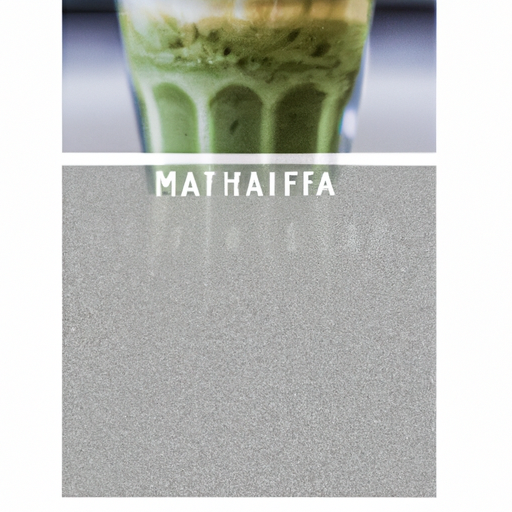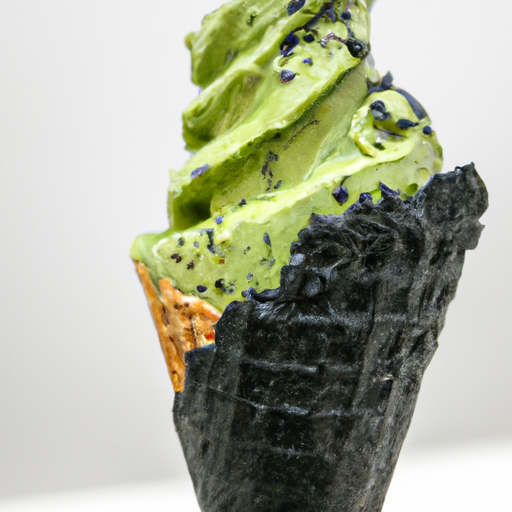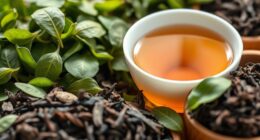There are multiple methods to make matcha sweeter, and as a long-time matcha drinker, I’ve tried various sweetening agents and proportions to discover the ideal taste combination for me.
In this article, I’ll share my knowledge and experiences of the different sweeteners that can be used to enhance the flavor of matcha, both natural and artificial, and how to combine them to achieve the perfect sweetness.
Matcha is a type of green tea that has gained popularity in recent years due to its numerous health benefits, including its high levels of antioxidants and ability to boost metabolism and energy. However, the taste of matcha can be quite bitter and strong, which is why it is often sweetened.
While some people may prefer to drink matcha without any sweeteners, adding a touch of sweetness can help balance out the flavors and make it more enjoyable. So, whether you are a seasoned matcha drinker or just starting out, read on to discover the best sweeteners to use and how to use them.
Key Takeaways
- Natural sweeteners like agave nectar, stevia, date sugar, and coconut sugar can be used to sweeten matcha.
- Honey, maple syrup, or artificial sweeteners like Stevia and Splenda can also be used to sweeten matcha.
- Milk and cream can be added to balance the bitterness and add a rich and creamy taste.
- Additional flavors can be added to matcha such as syrups, fruits, herbs, and spices to enhance the flavor and provide health benefits.
Overview of Matcha and Its Health Benefits
Matcha is a superfood that packs a punch of health benefits, making it a deliciously nutritious addition to your diet! This finely ground powder is made from specially grown green tea leaves, which are shade-grown to increase chlorophyll levels and enhance the flavor.
Matcha has a long history of cultivation in Japan, dating back to the 12th century, where it was used in traditional tea ceremonies. The traditional Japanese tea ceremony, or chanoyu, is a cultural practice that emphasizes the art of preparing and serving matcha tea. The tea is prepared with a bamboo whisk, called a chasen, and a ceramic bowl, called a chawan.
The process of preparing matcha is a meditative one, with the focus on the present moment and the appreciation of the beauty and simplicity of nature. While matcha is traditionally consumed without any sweeteners, some people prefer to add a touch of sweetness to balance out the bitter flavor. But what are the best natural sweeteners to use with matcha? Let’s explore some options.
Natural Sweeteners
You might be surprised by how well honey or maple syrup pairs with this green tea powder, as the old adage goes: ‘Opposites attract.’ When it comes to natural sweeteners, there are a few options to consider.
Here are four alternatives to using regular table sugar:
-
Agave nectar: This sweetener is derived from the agave plant and has a lower glycemic index than sugar, making it a great option for those watching their blood sugar levels.
-
Stevia: A zero-calorie sweetener derived from the leaves of the stevia plant. It’s sweeter than sugar, so a little goes a long way.
-
Date sugar: Made from ground up dates, this sweetener is high in fiber and nutrients like potassium and magnesium.
-
Coconut sugar: This sweetener is made from the sap of coconut palm trees and has a lower glycemic index than regular sugar. It also contains some nutrients like iron and zinc.
When looking for honey alternatives or sweetening without sugar, these natural sweeteners are a great place to start. Not only do they add sweetness, but they also come with added health benefits that regular table sugar doesn’t offer.
However, if natural sweeteners aren’t your thing, there are also artificial sweeteners to consider.
Artificial Sweeteners
When it comes to artificial sweeteners, I personally prefer using Stevia or Splenda to sweeten my matcha.
Stevia is a natural sweetener derived from the leaves of the Stevia plant, and it has a sweet taste without the added calories.
Splenda, on the other hand, is an artificial sweetener made from sucralose and has a similar taste to sugar without the added calories or carbohydrates.
Both options are great for those looking to reduce their sugar intake without sacrificing sweetness.
Stevia
If you’re looking for a guilt-free way to sweeten your matcha, stevia is a great option that won’t make you feel like you’re sacrificing flavor. Stevia is a natural sweetener that is extracted from the leaves of the stevia plant. It has become a popular alternative to sugar and other artificial sweeteners because it is calorie-free and does not raise blood sugar levels.
Here are some reasons why stevia is a great option for sweetening your matcha:
- Stevia is much sweeter than sugar, so you only need a small amount to sweeten your matcha.
- Unlike other artificial sweeteners, stevia has no known negative side effects.
- Stevia is a natural sweetener, so it is a great option for those who are trying to avoid artificial sweeteners.
Moving on to the next sweetener option, let’s talk about Splenda.
Splenda
Splenda, a popular artificial sweetener, has become a common substitute for sugar in many drinks and foods. Using Splenda in matcha is a great way to sweeten the beverage without adding any calories. One of the benefits of using Splenda in matcha is that it dissolves easily, making it convenient and easy to use.
However, it’s important to note that there are some risks associated with using Splenda in beverages. Splenda contains sucralose, which has been linked to digestive issues in some people. Additionally, some studies have suggested that consuming artificial sweeteners like Splenda may actually increase cravings for sugary foods and lead to weight gain in the long run. Therefore, it’s important to use Splenda in moderation and to be aware of any potential risks.
Despite the potential risks, Splenda is still a popular choice for those looking to sweeten their matcha without using sugar. It’s important to consider the potential benefits and risks before using it, but it can be a great option for those looking to reduce their sugar intake. With that said, let’s move on to the next section and explore the use of sugar in matcha.
Sugar
Sugar is the perfect way to add a burst of sweetness to your matcha that will make your taste buds dance with joy. Trust me, it’ll make your matcha taste like a million bucks!
While there are alternative options like honey, agave nectar, and maple syrup, sugar is a classic choice that never disappoints. It’s easily accessible and dissolves well in liquids, making it a convenient option for those who want to sweeten their matcha quickly.
Using sugar as a sweetener can have an impact on the flavor of your matcha, but it’s all about finding the right balance. If you add too much sugar, it can overpower the natural bitterness of the matcha and make it too sweet. On the other hand, if you don’t add enough, your matcha may taste bland.
I recommend starting with a small amount, like half a teaspoon, and adjusting to your taste preferences.
Adding milk or cream to your matcha is a popular way to balance out the bitterness and sweetness, and it’s the next topic we’ll be discussing. Whether you prefer dairy or non-dairy options, there are plenty of choices that can complement the flavor of your matcha.
So, let’s dive into the world of milk and cream and find the perfect addition to your sweetened matcha!
Milk and Cream
Sugar is a classic and straightforward way to sweeten matcha, but some people might prefer a creamier and more indulgent taste. Milk and cream are common options to add to matcha, and they can enhance the flavor and texture of the drink. As a matcha-loving AI, I enjoy experimenting with different dairy alternatives to find the perfect matcha latte recipe.
When it comes to choosing milk or cream for matcha, there are a few factors to consider. Whole milk can provide a rich and creamy taste, while skim milk can be a lighter and healthier option. For those who are lactose intolerant or vegan, plant-based milk such as almond, soy, or oat milk can also work well. One of my personal favorites is coconut milk, which adds a tropical twist to matcha and complements its earthy notes.
To make a matcha latte with milk or cream, simply froth the milk using a frother or a whisk until it becomes creamy and airy. Then, pour it into the matcha mixture and stir well. The resulting drink is not only sweet and satisfying but also visually stunning with its vibrant green color and frothy top. For an extra touch of decadence, sprinkle some cocoa powder or cinnamon on top of the latte.
While milk and cream can elevate the taste of matcha, some people might prefer a more flavored and complex experience. In the next section, we’ll explore how flavored syrups can add a new dimension to matcha and satisfy your sweet tooth.
Flavored Syrups
If you’re looking to add a little extra flavor to your matcha latte, you might want to try experimenting with flavored syrups. These sweet syrups are perfect for those who enjoy a sweeter taste in their drinks. They come in a variety of flavors, from classic vanilla to unique ones like lavender or rose.
To help you get started on your flavored syrup journey, here are some creative combinations you can try out: vanilla syrup with matcha for a classic combination, lavender syrup with matcha for a floral twist, and caramel syrup with matcha for a sweet and indulgent drink. You can also try making your own DIY recipes by mixing different syrups together or adding in other ingredients like cinnamon or ginger.
Flavored syrups are a great way to elevate your matcha latte game and create unique and delicious drinks. However, if you’re looking for a healthier option, you might want to try sweetening your matcha latte with fruits instead. Let’s explore some delicious fruit options in the next section.
Fruits
Adding fruits to your matcha latte is like adding a burst of sunshine to your day. Not only does it enhance the flavor, but it also provides a healthy dose of vitamins and fiber.
There are many fruits that pair well with matcha, including berries, mangoes, and pineapples. You can even create your own smoothie recipes by blending your favorite fruits with matcha and milk or yogurt.
If you’re looking to add a fruity twist to your baked goods, try incorporating matcha and fruits into your recipes. Matcha pairs well with citrus fruits like lemon and orange, as well as with berries and apples. You can add matcha powder to your cake batter or mix it with cream cheese for a delicious frosting. The possibilities are endless, and you can get creative with different combinations of fruits and matcha.
While fruits are a great way to sweeten your matcha, you can also experiment with herbs and spices to enhance the flavor. Some popular options include ginger, cinnamon, and mint. These ingredients add a subtle sweetness and depth to your matcha latte, giving it a unique flavor profile.
So, go ahead and mix and match different ingredients to find your perfect matcha drink.
Herbs and Spices
Mixing herbs and spices into your matcha latte can give it a unique and delicious flavor that will leave your taste buds wanting more. Not only do herbs and spices provide flavor, but they also have health benefits.
Here are three recipes using herbs and spices to sweeten your matcha without using sugar:
-
Cinnamon and Vanilla: Adding a dash of cinnamon and a drop of vanilla extract to your matcha latte can add a warm and comforting taste to your drink. Cinnamon has anti-inflammatory properties and can lower blood sugar levels, while vanilla has antioxidants and can reduce anxiety.
-
Ginger and Turmeric: For a spicy kick, add a pinch of ginger and turmeric to your matcha latte. Ginger has anti-inflammatory properties and can improve digestion, while turmeric is a powerful antioxidant and can reduce inflammation.
-
Mint and Lavender: Adding a sprig of fresh mint and a drop of lavender oil can give your matcha latte a refreshing and calming taste. Mint can aid digestion and reduce nausea, while lavender can reduce stress and anxiety.
Herbal alternatives to sugar are a great way to sweeten your matcha without adding processed sugar. By using herbs and spices, you not only add unique flavors to your drink but also receive health benefits.
In the next section, we’ll look at how to combine sweeteners to create a perfectly sweetened matcha latte.
Combining Sweeteners
Blending multiple sweeteners in your matcha latte can create a balanced and blissful flavor experience. When pairing with tea, it’s important to consider the flavor profile of your sweeteners.
For example, honey and maple syrup add a natural sweetness, while agave nectar and coconut sugar have a more subtle taste. Combining these different flavors can enhance the overall taste of your matcha latte.
When selecting sweetener brands, it’s important to choose ones that complement the flavor of matcha. Some popular options include Wholesome Sweeteners, SweetLeaf, and Madhava Natural Sweeteners. These brands offer a variety of sweeteners, including organic and low-glycemic options.
Experimenting with different sweetener brands can help you find the perfect combination for your matcha latte. In addition to trying different sweetener brands, experimenting with different ratios is also key.
Start with a small amount of sweetener and gradually add more until you reach your desired level of sweetness. It’s also important to consider the type of milk or milk alternative you are using, as this can affect the overall taste of your matcha latte.
With a bit of trial and error, you can create a perfectly balanced matcha latte that satisfies your taste buds. Trying different sweeteners and ratios can be a fun and delicious way to personalize your matcha latte.
Experimenting with Different Sweeteners and Ratios
To personalize your matcha latte, you can experiment with different sweeteners and ratios until you find the perfect combination for your taste buds. There are many sweeteners to choose from, but today we’ll focus on a few popular options: honey, agave, maple syrup, and coconut sugar.
Each sweetener has a unique flavor profile and sweetness level, so it’s important to find the right balance for your matcha latte.
-
Honey vs Agave: Honey is a natural sweetener that has a distinct floral taste. It’s a great option for those who prefer a sweeter latte. Agave, on the other hand, has a milder flavor and is less sweet than honey. It’s a good option for those who want to add sweetness without overwhelming the matcha flavor.
-
Maple Syrup vs Coconut Sugar: Maple syrup is a popular sweetener that has a rich, earthy flavor. It’s a good option for those who want to add depth to their matcha latte. Coconut sugar, on the other hand, has a caramel-like flavor and is less sweet than maple syrup. It’s a great option for those who want to add sweetness without overpowering the matcha flavor.
When experimenting with different sweeteners and ratios, it’s important to keep in mind that a little goes a long way. Start with a small amount and gradually add more until you find the perfect balance. Don’t be afraid to mix and match sweeteners to create a unique flavor profile that suits your taste buds.
With a little bit of experimentation, you can create a delicious and personalized matcha latte that’ll leave you craving more.
Frequently Asked Questions
What is the origin of matcha and how is it produced?
Matcha originated in China during the Tang Dynasty, but it was the Japanese who really developed the production process.
Matcha is made from shade-grown tea leaves that are hand-picked, steamed, and dried before being ground into a fine powder.
The shading process increases the chlorophyll content of the leaves, giving them a vibrant green color and a unique flavor profile. The leaves are then deveined and ground using traditional stone mills to create the powder.
This labor-intensive process ensures that the tea retains its natural sweetness and complex flavor. The result is a rich, creamy, and earthy beverage that is enjoyed around the world for its health benefits and unique taste.
How does matcha compare to regular green tea in terms of caffeine content?
Matcha and green tea both come from the same plant, but the way they are produced and consumed is quite different. When it comes to caffeine content, matcha has a higher concentration of caffeine than regular green tea. This is because matcha is made from the whole tea leaves that are ground into a fine powder, whereas green tea is made by steeping the leaves in hot water.
This means that when you drink matcha, you are consuming the entire tea leaf and all of its caffeine content. In addition to its caffeine content, matcha is also rich in antioxidants and has been shown to provide numerous health benefits such as boosting metabolism, improving concentration, and reducing stress levels.
So if you’re looking for a healthy and energizing drink, matcha is definitely worth trying.
Can matcha be used in baking or cooking, and if so, are there any special considerations?
Matcha is a versatile ingredient that can be used in various recipes, from baked goods to smoothies and even savory dishes. When using matcha in baking or cooking, there are a few special considerations to keep in mind.
First, it’s important to use a high-quality matcha powder, as lower quality options may have a bitter taste that can affect the overall flavor of your recipe. Additionally, matcha is a potent ingredient, so you may need to adjust the amount you use according to your taste preferences.
As for sweeteners, while traditional options like sugar or honey can work, there are also alternative sweeteners like stevia, maple syrup, or agave that can provide a different flavor profile. Experimenting with different matcha recipes and sweeteners can lead to delicious and unique creations.
What are some potential side effects of consuming matcha?
When it comes to matcha, there are a few potential side effects to keep in mind. For starters, matcha can be tough on the digestive system, particularly if you consume it on an empty stomach. Some people may experience stomach discomfort, bloating, or even nausea after drinking matcha.
Additionally, matcha contains caffeine, which can trigger anxiety in some individuals. It’s important to be mindful of your caffeine intake and to listen to your body if you notice any negative side effects.
Overall, matcha can be a healthy and enjoyable addition to your diet, but it’s important to consume it in moderation and pay attention to how your body reacts to it.
How does the quality and grade of matcha affect its taste and health benefits?
When it comes to matcha, the quality and grade can heavily impact both taste and health benefits. Matcha grades are determined by the part of the tea plant used, the processing method, and the level of shading the plants received.
Higher grades, such as ceremonial matcha, are made using the youngest leaves and have been shaded for longer periods, resulting in a sweeter, smoother taste and a higher concentration of beneficial compounds like antioxidants and amino acids.
However, taste preferences can vary greatly between individuals, and some may prefer the stronger, more astringent taste of lower grade matcha for certain purposes, such as in cooking or mixing with other ingredients.
Ultimately, choosing a matcha grade that aligns with your taste preferences and desired health benefits is key.
Conclusion
Well, folks, we’ve reached the end of our journey on how to sweeten matcha. I hope you’ve learned a thing or two about the various natural and artificial sweeteners available to enhance your matcha experience.
But let’s be real here, who needs sweeteners when you can just drink bitter, grassy water and pretend it’s delicious?
In all seriousness, experimenting with different sweeteners and ratios can really elevate your matcha game. Whether you choose to stick with natural sweeteners like honey or maple syrup, or go the artificial route with stevia or Splenda, the possibilities are endless.
And if all else fails, just throw in some milk and call it a day. Happy sipping, my matcha-loving friends!










